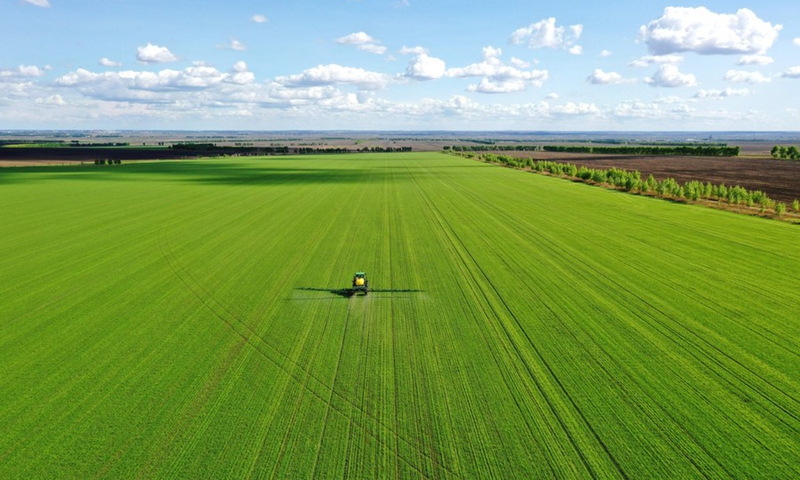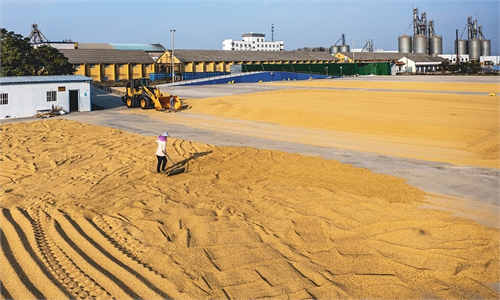Russia-Ukraine conflict could trigger global food crisis, but China’s agricultural security not threatened
Russia-Ukraine conflict could trigger food crisis, but impact on China less

Photo taken on May 27, 2021 shows a self-propelled sprayer at work on a farm in Heihe, northeast China's Heilongjiang Province. Photo: Xinhua
China's Ministry of Agricultural and Rural Affairs (MOA) and the Ministry of Finance issued a notice in recent days, requiring local authorities to mull an "all-out effort" to guarantee the harvest of summer wheat and expand the planting of soybeans "by all means," said a statement on the website of the MOA on Friday.
The notice, coming at a time when the protracted Russia-Ukraine conflict has stretched the global food supply ranging from corn and wheat to potash fertilizers, and pushed their prices to record highs, highlighted the latest of a concrete effort from the Chinese government to secure the spring plowing of staple grains and bumper harvest against the potential impact of geopolitical tensions.
While some politicians warned that the escalating situation could engulf the world in a potential food crisis, observers stressed that the storm is unlikely to threaten the food security of China - whose imports of wheat and corn only account for less than 10 percent of domestic consumption. The country's "rice bowls are firmly in its hands," analysts said, though they warned the need to guard against a spillover effect of a price hike from the global market.
According to the notice which identified the priority work for China's food production in 2022 and supportive policies, local authorities will release one-time subsidies to farmers to alleviate the impact of agricultural materials' price hikes. Authorities will also offer subsidies to corn, soybean and rice producers, raising the minimum purchase price of rice and wheat, as well as implementing planting subsidies to farmers who boost the crop cultivation of corn and soybeans.
The notice comes as Chinese authorities spare no effort to raise domestic production in spring plowing season, which started from early April. Against the backdrop of tensions between Russia and Ukraine, spring plowing is deemed as a critical cultivation season for Chinese farmers to boost wheat, corn, soybean and rice, which will be harvested from July to October the same year.
Ukraine and Russia account for over 20 percent of the global supply of wheat, barley and corn. Since the tensions escalated last month, wheat prices have increased by 21 percent, barley by 33 percent and some fertilizers by 40 percent, some of which have climbed to record levels, according to media reports.
Chinese Foreign Ministry spokesperson Wang Wenbin said at a regular press briefing on Friday that the Russia-Ukraine situation has dealt a heavy blow to global trade, finance, energy and the food supply chain, worsening an already struggling world economy.
French President Emmanuel Macron also warned of "an unprecedented food crisis" on Thursday during the G7 and NATO summits. He said the food crisis will be even worse in 12 to 18 months as Ukraine will not be able to sow crops, Reuters reported.
Analysts said it is not an exaggeration that the Russia-Ukraine conflict could spiral into a global food crisis, as their exports are quite diverse, involving a number of countries especially import-reliant countries in Africa and the Middle East.
Jiao Shanwei, editor-in-chief of cngrain.com, told the Global Times on Friday that the current price hike of agricultural products is mainly due to logistics hurdles and panic. "In the long term, ongoing tensions also disrupt Ukraine's spring crop sowing, which has detrimental implications for the upcoming 2022/23 harvest seasons."
The dwindling supply could pose a threat to low-income countries, and further drive inflation in developed nations including the US and Europe, though the impact on China's food security could be "much smaller and limited," said Li Guoxiang, a research fellow at the Chinese Academy of Social Sciences.
China only imported 5.9 percent of wheat last year, and most was sourced from the US and Canada. A Citi report also showed that only 9.4 percent of domestic corn consumption in 2021 came from imports. And Ukraine supplies around 30 percent of China's corn imports.
China has the capacity to meet domestic corn consumption, and the demand gap left in recent years was due to the difference in price between the domestic and international market, which slashed domestic farmers' willingness to plant corn, Jiao explained. As such, it is relatively easy for the world's second-largest economy, with stimulating policies, to fill up the 30 percent void of Ukraine corn imports.
According to Jiao, China has also stockpiled staples such as corn, sorghum, and wheat in the past two years - when prices were relatively affordable - as part of top-down efforts to prioritize national agricultural safety.
Chinese Premier Li Keqiang said during an inspection visit to the MOA on Wednesday that China should always stand on guard over its food security and ensure stable production and supply to hedge external uncertainties.
On Wednesday, China also released a million tons of potash fertilizer reserves to meet the production needs during this year's spring farming period, according to the country's top economic planner.
The country has set a goal to ensure grain output for 2022 above 650 billion kilograms, according to this year's government work report.


